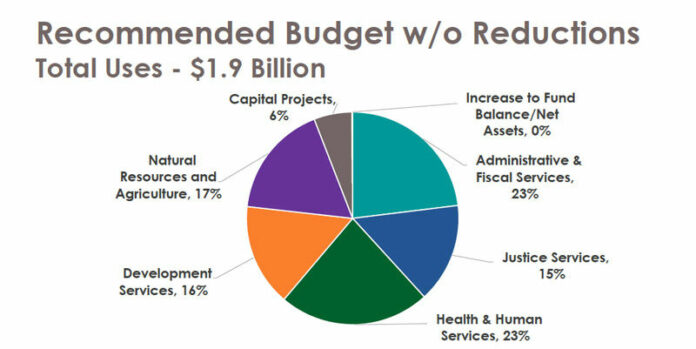Four more years of tough deficits predicted
Facing a triple whammy from wildfires, the coronavirus pandemic and a rude recession, the Sonoma County Board of Supervisors did their best to “whistle past the graveyard” and last Friday adopted a $1.9 billion 2020-21 budget.
The board started its budget deliberations at the beginning of last week confronting a potential $45.7 million deficit and the prospect of cutting as many as 100 jobs. But the board backfilled its budget with one-time funds from a PG&E 2017 wildfire settlement ($24.6 million) and federal and state stimulus funds aimed to fight the COVID-19 pandemic and related financial impacts.
The supervisors expressed unanimous relief in avoiding deeper cuts in their 2020-21 budget, while also giving themselves a sober reminder that the county faces projected annual deficits averaging $35.3 million for each of the next four years.
At the beginning of their annual budget talks, Sonoma State University economics professor Robert Eyler schooled the supervisors to not expect an economic recovery until at least 2023, due to the loss of local tax receipts and other local economy losses.
Almost half (41%) of the county’s operations, services and departments are funded by state and federal monies and grants. Another fourth (23%) traditionally is derived from sales, tourism-related and property transaction taxes. Most of the remaining revenues (17%) are collected as permit and service fees. Plus, each year usually comes with one-time funds such as this year’s Federal Emergency Management Agency (FEMA) reimbursements and COVID-19 response grants.
The county employs just over 4,000 employees in 25 departments that provide health and social service programs, public parks and open space, a regional water wholesaler (Sonoma Water), law enforcement and court system, land use and planning regulations and road and transportation infrastructure and maintenance. The largest sector is the collection of human service departments that employ 890 workers. The semi-autonomous sheriff’s department has 635 uniformed and support staff. The county’s public health division employs 529 and Sonoma Water has 233 employees.
In the final $1.9 billion budget, none of the listed employees lost a job, with just 55 county positions marked for elimination, all of which are currently vacant.
County administrator Sheryl Bratton and fiscal analyst Peter Bruland recapped for the board the millions of dollars of impacts to the county’s treasury from the ongoing rash of wildfires and the costs to test, fight and recover from the COVID-19 pandemic.
Absent from the many updates was an open mic discussion about the county’s worsening pension fund which has suffered a staggering loss of $356.7 million in the first six months of 2020. The county’s general fund must pay 40% of total pension obligations to the 4,812 retirees. The $217.7 billion fund also depends on annual investment dividends but the fund had a low performing year in 2018 and now faces another recessionary period of uncertain stock markets and overall economic activity. Pension-caused impacts on future general fund budgets will worsen until a full economic recovery arrives, mirroring the county’s experience during the 2008 Great Recession.
These unfunded pension obligations owed to current and future county retirees are not included in the efforts to balance the 2020-21 budget.
Pointing to a list of budget “highlights” Bratton’s office listed the following:
• $20 million in set-aside funding for COVID-19 response including expanded testing;
• $8.5 million in PG&E funds to backfill the county’s reserve funds, which were depleted during the 2017 fires;
• $5.5 million to expand the county’s Mobile Support Team (for a period of three years), to respond to mental health crisis calls;
• $2.24 million set aside in an economic uncertainty fund;
• $2 million to assist with the purchase of two hotels – the Hotel Azura in Santa Rosa and the Sebastopol Inn in Sebastopol — to be used for permanent supportive housing through the governor’s Project Homekey program;
• $1.4 million over the next two to three years to expand support for the Independent Office of Law Enforcement Oversight (IOLERO) including the addition of two attorneys;
• $920,000 for vegetation management services and a potential future fire revenue measure
• $384,000 for food distribution and senior services;
• $355,000 to strengthen overall support for homeless services and Home Sonoma Leadership Council, the primary decision-making body for the Sonoma County homeless system of care.
Threatened cuts to the sheriff’s substations at Guerneville and Sonoma Valley and the grounding of the helicopter Henry 1 were avoided in last minute funding shifts.
While the county allocated $24.6 million in PG&E settlement funds as part of the 2020-21 spending plan, the Board of Supervisors will consider on Oct. 6 on how to allocate the balance of the $149 million 2017 wildfire settlement money. The public can make suggestions on how to spend the PG&E funds via an online survey (https://www.surveymonkey.com/r/PGE_English) before Sept. 14.









